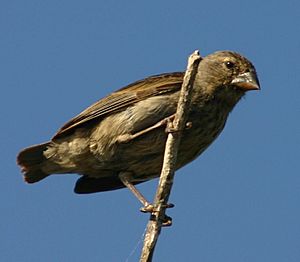Small ground finch facts for kids
Quick facts for kids Small ground finch |
|
|---|---|
 |
|
| female, Fernandino 976. | |
| Conservation status | |
| Scientific classification | |
| Genus: |
Geospiza
|
| Species: |
fuliginosa
|
 |
|
The small ground finch (Geospiza fuliginosa) is a small bird that lives only on the Galápagos Islands. This means it is endemic to these islands – you won't find it naturally anywhere else! It belongs to the tanager family, which is called Thraupidae by scientists. These birds are very common and live in many places like shrublands and forests on most of the Galápagos Islands. They often eat small seeds. They also help other animals by eating tiny parasites from the skin of Galápagos land and marine iguanas, and even Galápagos tortoises.
Contents
What is a Small Ground Finch?
The small ground finch is one of the famous "Darwin's finches". This is a group of birds that are closely related. They all evolved (changed over a very long time) on the Galápagos Islands. These finches are related to birds called Tiaris grassquits, which live in South America and the Caribbean.
How the Small Ground Finch Got Its Name
When Charles Darwin first saw and collected this bird in 1835, he thought it was a type of finch. John Gould, a scientist who officially described Darwin's bird samples, agreed. He first put it in the same group as Old World finches.
But by 1841, Gould changed his mind. He moved this bird and five others into a new group called Geospiza. This was still a group of finches, but different from the Old World ones. Later, DNA research showed that all of Darwin's "finches" are actually tanagers, not true finches!
The name Geospiza comes from two Greek words. Geo means "ground", and spiza means "finch". The second part of its scientific name, fuliginosa, is a Latin word that means "sooty". This probably refers to its dark color.
Sometimes, though rarely, the small ground finch can hybridize (have babies with) the medium ground finch.
What Does a Small Ground Finch Look Like?
The small ground finch is the smallest of all the ground finches. It is about 11 cm (4.3 in) long. It has a short, pointed beak with a slightly curved top part.
Its beak is usually smaller than the medium ground finch's beak. However, on islands where only one of these finch species lives, their beak sizes can be very similar. On islands where both species live and compete for food, their beaks tend to be more different in size.
Male small ground finches are black. They have white tips on the feathers under their tail. Females and young birds are brown with streaky patterns on their undersides.
Highland vs. Lowland Finches
Finches living in high areas (highlands) look a bit different from those living in low areas (lowlands). This is likely because they have adapted (changed to fit their environment). Highland finches have larger, more pointed beaks. They also have smaller feet and claws compared to lowland finches.
These finches show a cline, which means their traits change gradually along a continuous slope, like an elevation gradient. In areas where highland and lowland finches meet, called a "hybrid zone", the birds have traits that are in between the two types. This is an example of parapatric speciation. This means that the difference in elevation (about 560 meters) causes the birds to develop different traits. However, the hybrid birds in the middle zone are still well-suited to their environment.
Where Do Small Ground Finches Live?
Like almost all of Darwin's finches, the small ground finch lives only on the Galápagos Islands. It is very common and found on almost every island in the group. The only islands where it is not found are Genovesa, Wolf, and Darwin islands.
These finches are most common in dry coastal areas and places where different types of habitats meet. After the breeding season, they sometimes move into the higher parts of the islands.
How Do Small Ground Finches Behave?
What Do Small Ground Finches Eat?
The small ground finch is an omnivore, meaning it eats both plants and animals. However, it mostly prefers plant matter. It usually finds its food on the ground or in low plants. It eats seeds, buds, flowers, leaves, and sometimes insects.
These finches also have a special symbiotic relationship (a helpful partnership) with Galápagos tortoises and both marine and Galápagos land iguanas. They help these reptiles by picking off parasites from their skin.
What Does a Small Ground Finch Sound Like?
The song of the small ground finch is quick and not very loud. People describe it as sounding like "twichooo-twichooo" or "teur-weee".
Protecting the Small Ground Finch
Even though we don't know the exact number of small ground finches, they are very common across the Galápagos Islands. Because of this, the International Union for Conservation of Nature (IUCN) lists them as a species of "Least Concern". This means they are not currently in danger of disappearing.
Their numbers seem to be stable. Their population size and the area where they live are not close to any levels that would cause worry.
However, like all animals that live only on the Galápagos Islands, they can be affected by human activities. These include fires, too many farm animals eating plants (overgrazing), and the introduction of new animal or plant species that don't belong there.
The small ground finch lives in ten of the "Important Bird Areas" that have been set up on the islands to protect birds. Sadly, these finches can suffer from high death rates due to a parasitic fly. In one study from 2002 to 2006, between 16% and 95% of finches died because of this fly.
See also
 In Spanish: Pinzón de Darwin fuliginoso para niños
In Spanish: Pinzón de Darwin fuliginoso para niños


